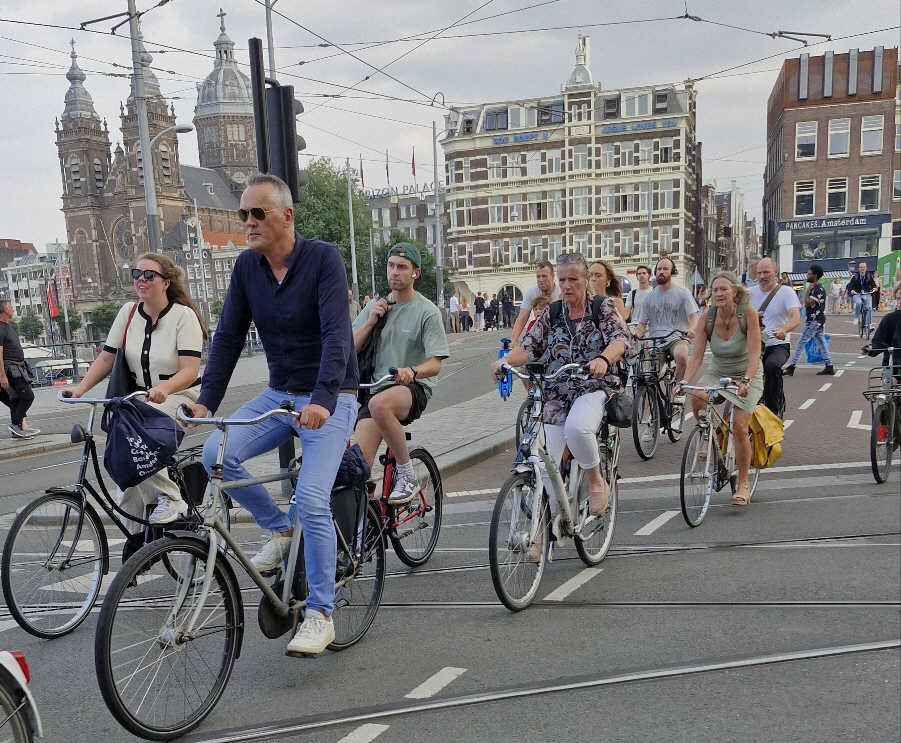Doughnut Economics and a Bike City
By Chung Hyunhwa
The bicycle has a history of over 200 years, but its popularity soon appeared to be on the decline due to the advent of the automobile. Recently, however, more and more cities are incorporating bicycles into their transportation systems in an effort to deal with the rapidity of climate change. Bikes are completely free of carbon release, convenient and fast, good for the health, and very economical. I recently visited Amsterdam in the Netherlands on a business trip, and I would like to share how this bike riders’ heaven is providing a realistic vision of a sustainable future.
Amsterdam is extraordinarily unique with its numerous bikes filling the city. I remember Namwon in Jeollabuk-do was like present-day Amsterdam when I was young with its numerous bikes, but they were soon replaced by automobiles in the 1990s. Amsterdam was also a busy city with a lot of cars at one time, but there were two things that transformed it into the bike kingdom that it currently is. One was the increasing death toll from the numerous automobile accidents that also killed young children. The other was the oil crises of 1973 that led to banning the use of private cars on Sundays for three months. There were demonstrations to change the roadway system and the city transportation design, especially by the parents of the lost children.
During the car-ban period, people realized how nice it was to walk, to ride bikes, and to enjoy the car-free streets for various activities. These experiences led them to reach the social agreement to incorporate bikes into their transportation system, and as a result, the Netherlands became a country with 23 million bikes and 35,000 kilometers of bike paths covering the entirety of the country over the past 50 years. Considering the entire population is only 17 million and the land area is only one-third the size of South Korea, this is more than impressive. They changed their transportation system with their collective intelligence and wisdom.
In Amsterdam, it is faster to get anywhere on a bike than by car. The car lanes are often one way and the speed limit is strict. Parking a car is difficult and very expensive, too. Most bike lanes are as wide as car lanes, and bike lanes are respected by pedestrians and cars. For example, on a wide street, there are two bike lanes, two-way tram rails, and a car lane. There are cars, but they do not occupy the entirety of the streets. I did not see any cars that are going fast or that were loud during my stay in the city. I even saw trams stop for pedestrians and bikes. Pedestrians and bike riders certainly have the right of way there. The streets in Amsterdam are always busy with walking tourists, citizens on bikes, and with trams and cars. I was impressed by the order in the streets, accompanied by a sense of freedom. The air quality is a plus due to there being so few cars.
The typical Dutch bike may be a little different in the way that you ride: one sits very upright without bending forward. Bikers use a lot of accessories for practical purposes – to carry children, groceries, and bags. Their bikes also have a part called the “coat guard” that keeps the rider’s change of clothes for the office or school from getting caught in the wheel. Their bikes may be a little different, but what is really different is not the bikes but the infrastructure and the system.
Besides the bike paths across the country, the Netherlands’ bike parking facilities are also very well organized in the form of bike racks on streets and bike parking garages. The Dutch also get actual tax benefits for using bikes. Even helmets are not required, so they can ride without ruining their hair styles. The Dutch say that it is healthier to cycle without a helmet than to never cycle at all. They incorporate everything that will encourage people to ride bikes rather than drive a car. With this effort, 70 percent of the population use bikes to go to work or school, and of course, the Dutch are all fit and slim. If you ride a bike every day, it is probably more difficult not to be fit.
Amsterdam has recently been adopting “doughnut economics,” which focuses on a balance between life’s essentials and the ecological ceiling. Humans should consume to live, but only as much as they need. Based on this philosophy, policies are made, and people agree to follow them. The Dutch have always had challenges because their land is lower than sea level, but they have dealt with it by developing advanced technologies to control the water. Still, the rising sea level due to climate change is becoming a greater threat nowadays, so they continue to seek solutions. Biking is definitely one of their actions to fight climate change, and now Paris and London have joined in as well.
I think Gwangju should be the first example city in Korea to join this movement to show that bike transportation can actually create a lively and clean city environment. Some say there should first be more bike riders and that the infrastructure would then follow, but I think that advantageous infrastructure is needed to trigger a bike-riding culture. With our collective intelligence and volition, I don’t think it is impossible.
The Author
Chung Hyunhwa, a native of Gwangju, currently works for a horticultural company. She led the international eco-hike group Gwangju Hikers at the GIC in 2020 and 2021. Previously, she taught English at Yantai American School and Yantai Korean School in China and worked in school administration at Branksome Hall Asia in Jeju. She holds a master’s degree in TESOL from TCNJ in the U.S. and a license to teach Korean. She loves plants, birds, and repurposing items creatively.




